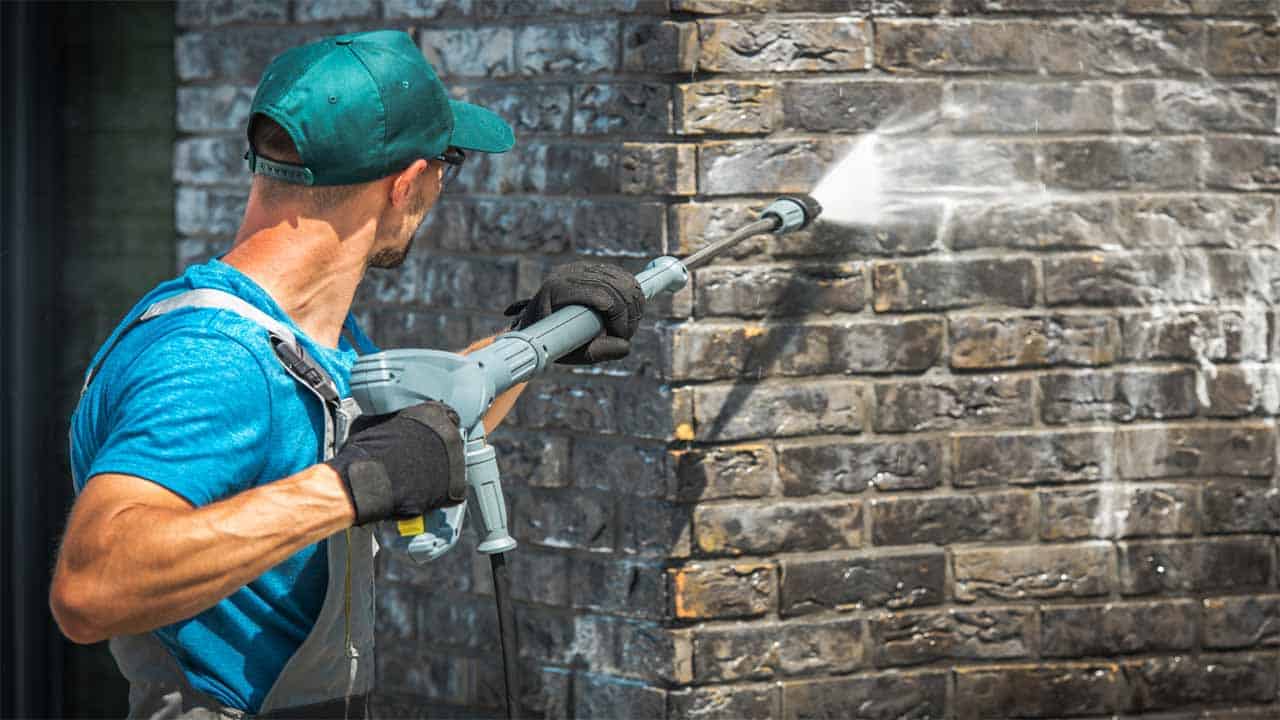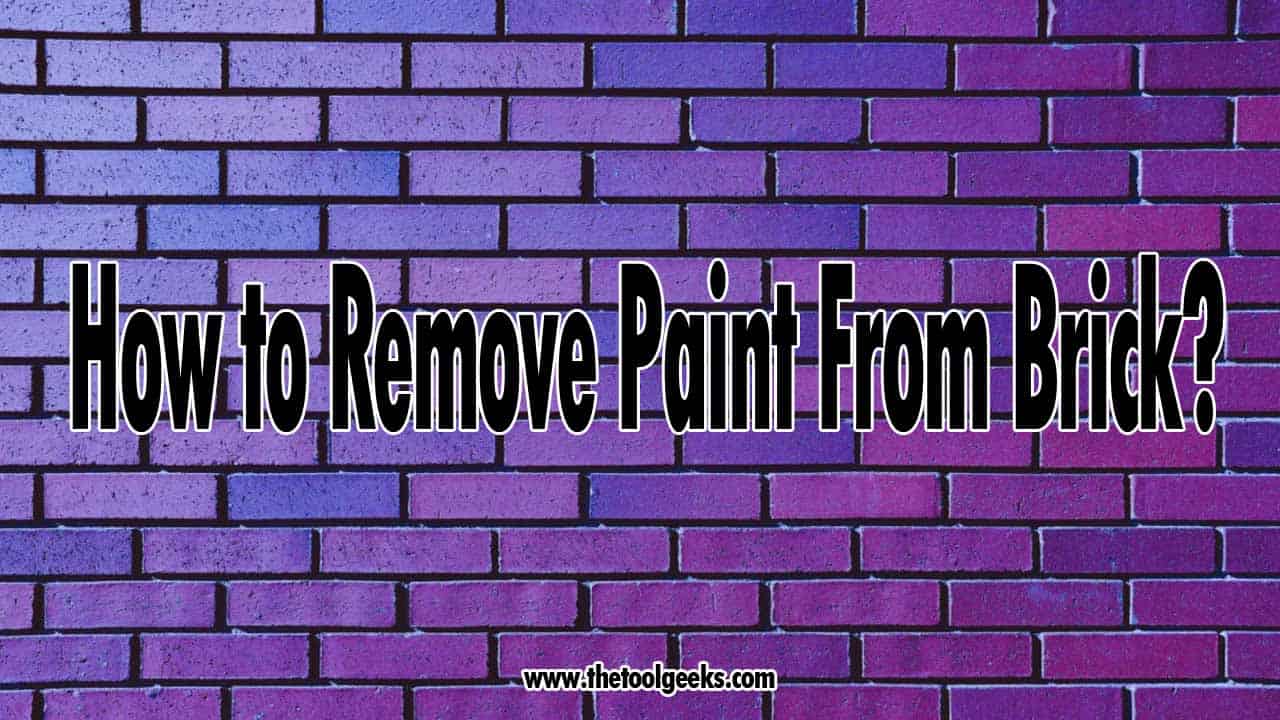How to Remove Paint From Brick: 10 Steps You Have To Do
TheToolGeeks.com is a participant in the Amazon Services LLC Associates Program and other affiliate advertising programs. We may earn from qualifying purchases. (Learn More).
People remove paint from brick for different motives ranging from maintenance reasons to aesthetic designs.
Either you are a professional painter or a DIYer, one thing you should know is that removing paint from a brick wall is not the easiest of tasks especially if you are working on old brick.
This is because many of the methods you can use to remove paint from other surfaces like concrete and wood will not do well on brick.
Methods such as sandblasting and power-washing will do more than just remove the paint stain if used on old brick.
These methods may alter the condition of the brick leaving you with a bigger problem on your hands than just the paint.
Jump To Page Contents:
Can You Use Paint Removers For Bricks?
Most of the advertised active solvents and paint removers will damage the brick wall. This is because many of these solvents and paint-removers have a high pH level that can be harsh on the brick and can cause discoloration. Not to mention the fact that some of the chemicals used in making these paint removers can be toxic too.
So if you can’t use strong chemical-based paint removers and power-washing isn’t great for brick either, what is the best way to remove paint from brick?
Well, the simple answer is using a paint stripper. Paint strippers work wonderfully on brick because they soften the paint on the brick and make it easy to peel the paint off after a while but that’s not all.
What type of paint stripper should you use? How should you prep the brick before applying the paint stripper? And what tools do you need to remove paint from brick? You see there is a lot more to know about removing paint from brick. So let’s get to it.
What Type of Paint Stripper Should You Use on Brick?
The best paint stripper to use on brick would be fabric-based paint strippers or you can vie for gel-based paint strippers as well. These paint strippers ninety percent of the time will do all the work for you. You just have to apply a thick coat of the stripper on the brick wall and wait for the time frame stated by the manufacturer for the paint stripper to work.
Most fabric-based paint strippers would require you to wait for a few hours after applying the stripper and peeling strips before removing it.
The time frame will allow the paint stripper to work its magic properly. The fabric-based paint stripper comes with peeling strips that are placed on the surface after applying the paint stripper.
The paint stripper softens the paint making it possible for the paint to stick to the strips which are then peeled off after a few hours.
The downside to this is that many of these gel-based and fabric-based paint strippers aren’t cheap. Getting one would require you to spend more than you would originally on regular solvents and paint removers.
Related Read — Best Sprayers For DoorsTools Needed to Remove Paint From Brick
- Paint stripper preferably fabric-based paint stripper. There are different products out there. You should get the one that is designed for brick and masonry.
- Metallic putty knife or a trowel
- Peeling strips.
- A thick brush
- Rags
- A respiratory mask
- A pair of work gloves
- A pair of goggles
- Duct tape
How to Remove Paint From Brick?
Either you are a professional painter that got hired or you are a DIYer who doesn’t mind getting his or her hands dirty, the following steps will guide you on the best way to remove paint from brick.

Find Out the Type of Brick You Have and the Paint Used on the Brick
One reason removing paint from brick is usually tough is because of the lack of knowledge about the brick. Before trying to remove the paint, you should know the type of brick you are working with and the type of paint that was used on the brick.
Brick is usually made from a mixture of water, sand, and clay or shale that is refined to be more durable and stronger. Though modern bricks now include Portland cement.
For the paint, it’s most likely latex paint was used on the brick as it’s the most popular type of paint used on brick. If it’s not latex paint, then it should be oil-based paint.
Finding out the type of brick and paint used will help you pick the best type of paint stripper to use and the appropriate method of removal.
Put on Your Safety Gear
Before embarking on any task, you should ensure your safety. Put on a pair of work gloves, a respiratory mask, and a pair of goggles to protect you from any potential accident.
The components of some of the products you would be using might be harmful to your skin especially if you have really sensitive skin.
Related Read — Best Sprayers For Lacquer PaintPrep the Workspace
Before going ahead to remove the paint, you need to ensure the workspace is properly prepared. If it’s a brick wall, you need to remove any adornment or object like wall clocks, picture frames, and furniture from the wall.
Also, remove any furniture or electronics nearby. If there is anything you can’t remove such as heavy furniture, you should use drop cloths or a plastic sheen to cover the object to prevent damages or stains.
Also, use the drop cloth or plastic sheen to cover the floors near the brick surface. This prevents any unnecessary stain from getting stuck on the floors. You might want to use duct tape to seal the drop cloth to the floor.
This would prevent the drop cloth or plastic sheen from moving out of place due to the traffic on the floor. If this isn’t done, you will have to take time regularly to readjust the drop cloth and this will just lead to you spending more time on the task.
Test the Paint Stripper
Professional painters usually advise testing any paint removal product on a part of the intended surface before you go ahead to use it on the whole surface.
By testing the paint stripper, you get to know if the paint stripper you got is indeed ideal for the brick. You also get to know the estimated time to wait before the paint stripper fully removes the paint.
As a plus, testing the paint stripper helps you to know the underlying condition of the brick wall and if you want to continue the task.
For instance, if you test the stripper and you found out that the paint was used to hide some imperfections in the brick, you might decide to leave the paint on rather than expose the imperfect bare brick wall.
Scrape the Paint Off
The next thing to do is to scrape the paint off. Though the fabric-based paint stripper will remove multiple layers of paint, it’s usually best to scrape off as much paint as possible from the brick before applying a paint stripper.
To do this, use a metallic put knife to remove the loose paint from the brick wall. This allows the stripping compound to work well.
Related Read — Review Of Commercial Paint SprayersApply the Paint Stripper
After scraping away the loose paint, you can go ahead to apply the paint stripper. Paint strippers are usually sold in canned containers.
Use a metallic putty knife to scoop some paint stripper and apply it to the surface. The paste is usually very thick so you will need to use the metallic putty knife to press the stripping compound on the brick surface well.
Bricks usually have tiny holes, gaps, and crevices. Make sure the paint stripper is properly applied to these nooks and crannies to prevent any surprises when you are done.
You should apply as much layer of the paint stripper as required by the manufacturer. Usually, two or three layers should be enough.
Related Read — How to Remove Paint Off Carpets?Place the Peeling Strips on the Paint Stripper
After applying the paint stripper, place the peeling strips on it. The peeling strips are usually made of fabric. After a while, the paint stripper softens the paint on the brick and the paint sticks to the peeling strips.
After some time, you can peel the strips off the wall and the paint and the paint stripper will come off with it. Think of it as waxing your skin, only that with your skin, you will remove hair while on the brick, you are removing paint.
Wait for the Stipulated Time
After you have placed the strips on the surface, you need to exercise patience so the paint stripper can work its magic on your brick.
Fabric-based paint strippers take between 8 hours and 24 hours to remove the paint from the surface. The time frame is subject to the size of the task and the product you are using. Some products take a longer time frame for the stripper to work.
Luckily, this can be a plus for you if you have other things on your to-do list. As a tip, always check on the brick regularly. The paint stripper may work faster than expected. The time frame needed is usually inscribed on the container.
Related Read — How to Remove Paint Off Concrete?Remove the Peeling Strips
After waiting for the time stipulated by the manufacturer, you can go ahead to remove the peeling strips. As a precautionary tip, do not RIP the strips off the wall.
This will cause you to tear the strips. Gently pull the strips off and the paint will come off with it. If you notice any residue either from the paint stripper or the paint, you can use the metallic putty knife or a sharp blade to scrape it off. You can also use a thick brush and warm water to scrub off any excess.
After removing the peeling strips, follow the manufacturer’s instructions on how to dispose of them. While some peeling strips can be easily disposed of, some will require you to use chemicals to neutralize the chemical reaction of the paint stripper.
Related Read — How to Spray PolyurethaneClean the Brick
If you have achieved the desired level of cleanliness on the brick, you should go ahead to clean the brick and the workspace.
You can use a damp cloth to wipe the surface of the brick thoroughly. This will further expose the brick. By cleaning the brick, you will also have a clearer view of the wall and you will be able to point out any imperfection or any residue that needs attention.
If you have done all of the above, then you should have a paint-free brick wall.
Related Read — How Much Does it Cost To Paint Your Car Rims?Expert-tips to Follow While Removing Paint From Brick
- DO NOT use caustic solvent or caustic paint removers. Caustic paint removers and solvents would be absorbed by the brick and this can cause long-lasting damage.
- DO NOT attempt to paint or remove paint from brick walls during the winter season or when the temperature is chilly. If you suspect winter is around the corner, it’s best to postpone any paint removal or application task. If you paint brick when the weather is freezing, the paint wouldn’t cure (dry) properly.
Also, if you remove paint from brick when the weather is cold, the brick wouldn’t dry well and the increased moisture from the weather can damage the brick.
- ALWAYS remove as much paint and debris as you can from the brick before you apply the paint stripper. If this isn’t done, the paint stripper wouldn’t work properly. You will end up using more layers of paint stripper and wasting more time than you would initially.
- ALWAYS follow the manufacturer’s instructions regarding how to use the paint stripper. This includes the number of layers needed and the time frame for the paint stripper to cure properly.
So there you have it. The best way to remove paint from brick has been finally revealed. If you have any comments or questions about removing paint from brick, kindly leave them below and I’ll attend to them as soon as possible. Have a nice paint-removing experience.
Related Read — How To Remove Paint From Skin?Amazon and the Amazon logo are trademarks of Amazon.com, Inc, or its affiliates.

